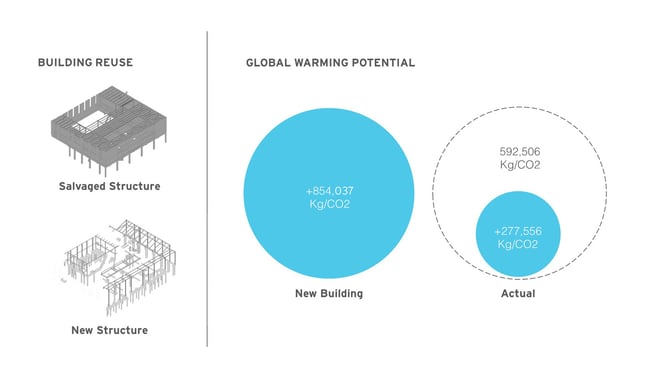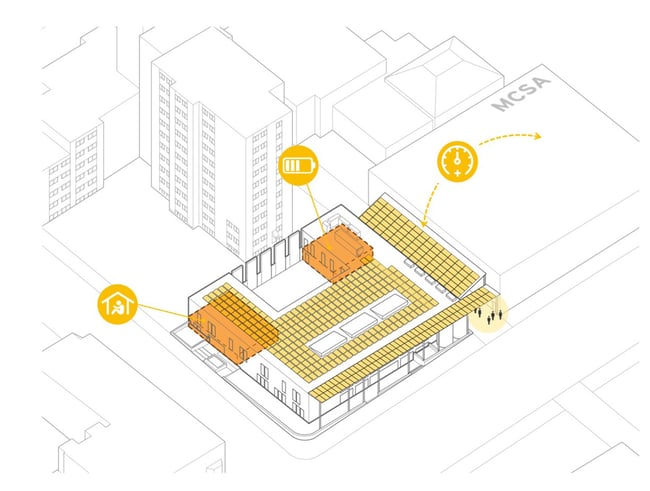Carbon-Free Resiliency: The LBC Energy Petal at the Stanley Center

The built environment accounts for nearly 40% of greenhouse gas emissions, making it one of the biggest obstacles in the fight against climate change. Most buildings rely on non-renewable fuel sources like coal, oil, and natural gas, and in the coming years, we must find ways to switch to carbon-free alternatives.
The Living Building Challenge (LBC)—a third-party building verification system—helps catalyze much-needed change. Its Energy Petal encourages efficiently designed buildings that operate year-round in a pollution-free manner.
The Stanley Center for Peace and Security’s new headquarters in Muscatine, Iowa is on track to receive a full Living Building Certification from Living Future. Following the Energy Petal, it’s designed to produce 105% of its energy through on-site renewables.
This article will explain the Energy Petal, its imperatives, and the methods deployed at the Stanley Center to meet the LBC’s energy goals.
Understanding the Energy Petal
The LBC is the most rigorous approach to sustainability in the built environment. Its framework is broken into seven categories known as Petals, which include:
The Energy Petal focuses on the energy used to operate buildings. It envisions a safe, resilient, and decentralized energy infrastructure, powered by renewables.
Each LBC Petal is broken into separate requirements called imperatives. The Energy Petal includes two: Energy and Carbon Reduction and Net Positive Carbon.
The Energy and Carbon Reduction imperative requires projects to reduce their total net annual energy consumption compared to similar existing buildings. Energy reduction requirements differ across building types. For example, new buildings must achieve a 70% reduction from an equivalent building standard, and existing buildings must achieve a 50% reduction.
Projects must also demonstrate a reduction in embodied carbon—the emissions associated with building materials.
The Net Positive Carbon imperative encourages the use of carbon-free renewable energy. Fully certified projects must supply 105% of their net annual energy needs through on-site renewables. Projects must also develop resiliency strategies with enough on-site energy storage to be habitable for a week.
The Energy Petal at the Stanley Center
Reducing Embodied Carbon and Improving Efficiency
When selecting a site for its new headquarters, the Stanley Center opted to renovate the former Musser Public Library. The building provided a prime downtown location for strengthening community connections and an opportunity to tie into Muscatine’s history.
From a sustainability perspective, reusing the structure helped minimize the introduction of carbon-heavy building materials like concrete and steel. The project reused 94% of the existing building by mass, saving 2/3 of the embodied carbon used in new construction. This reduction is equivalent to the sequestration of 560,000 trees.

Reusing an existing structure saved 2/3 the amount of embodied carbon.
At the same time, the team worked to improve the building’s efficiency, making on-site energy production more feasible. Performance modeling performed by Willdan helped the team discover the most impactful areas for investment.
A new VRF mechanical system with an energy recovery unit reduced the amount of energy needed to heat and cool the building. To minimize thermal bridging, the team added a rain screen with five inches of mineral wool over the existing red brick structure.
A courtyard carved from the existing building and skylights helped increase daylighting and minimize electric light use. Before renewables, the building achieved an Energy Use Intensity (EUI) score of 26.3 KBTU, significantly lower than similarly sized buildings.
On-Site Solar Energy Production
After reducing the building’s energy load, the design team could determine how much energy the site needed to produce. Our partners at Design Engineers planned the initial solar design, determining the need for an 8,100-square-foot solar array.
Although the courtyard was necessary for daylighting and urban agriculture, its addition limited rooftop space for solar panels. As such, the team opted for solar canopies over the front entrance and neighboring alley.
Along with increasing energy production, the solar canopies provided additional benefits. They protect patrons of a neighboring non-profit, the Muscatine Center for Social Action (MCSA), from inclement weather while aiding rainwater collection. Water collected on the canopies flows to a centralized rooftop location where it can be filtered and used within the building.
Ideal Energy installed the solar array toward the end of construction. Although LBC projects must produce 105% of their energy on-site, the Stanley Center’s array was designed to produce 110%, providing additional room to meet the requirements.
Additional power feeds into the centralized grid through a process called Net Metering. Overproduction in warmer, sunnier months helps make up for lower averages in the winter.
Promoting Resiliency
Lastly, the Stanley Center was designed to be habitable for at least a week in the event of a natural disaster.
A 172-Kilowatt Hour battery bank can power a portion of the building for three to four days, maintaining the building’s electrical and water systems in case of a power outage. With solar power, these batteries can recharge continuously.

The battery bank allows for continued operations in the habitable zone.
Resiliency is a vital part of the LBC. As climate change makes extreme weather events more common, such strategies can help communities protect vulnerable populations.
While the Stanley Center cannot shelter an entire community, it sets an example, showing other building owners how on-site energy production can improve resiliency in the face of the unknown.
Learn More About the Living Building Challenge
The Energy Petal is one of the most important aspects of the LBC. To address climate change, we must transition away from fossil fuels and find new ways to power our buildings.
Projects like the Stanley Center set a precedent, showcasing the possibilities of net-zero building operations. As the project embarks on its first operational year, we will continue to monitor and verify the success of its solar power system and resiliency strategies.
The LBC is an exciting opportunity to demonstrate your organization’s values and strengthen your community. It requires an integrated project team and an inclusive process that engages stakeholders. Learn if the LBC is right for you by reading about the questions to ask before pursuing.